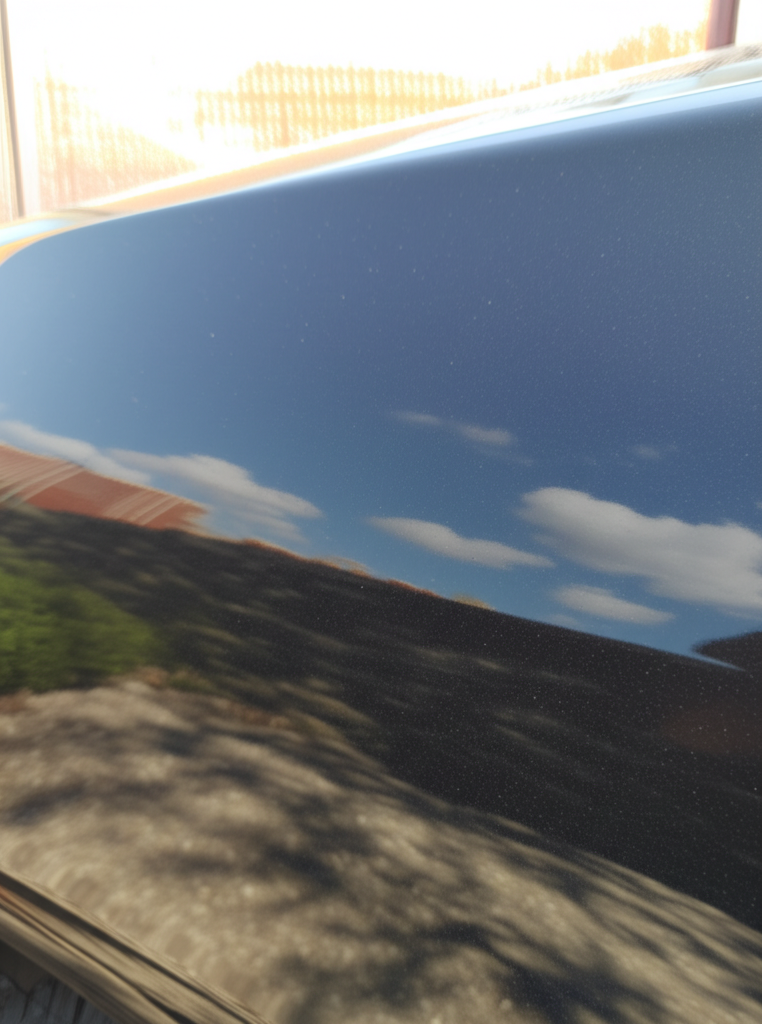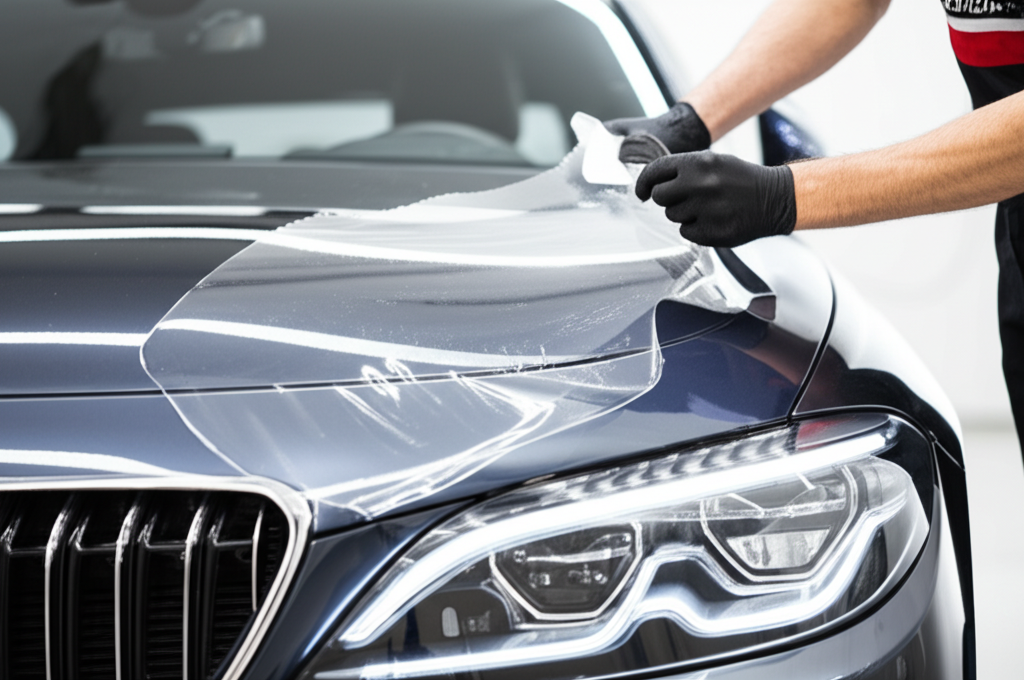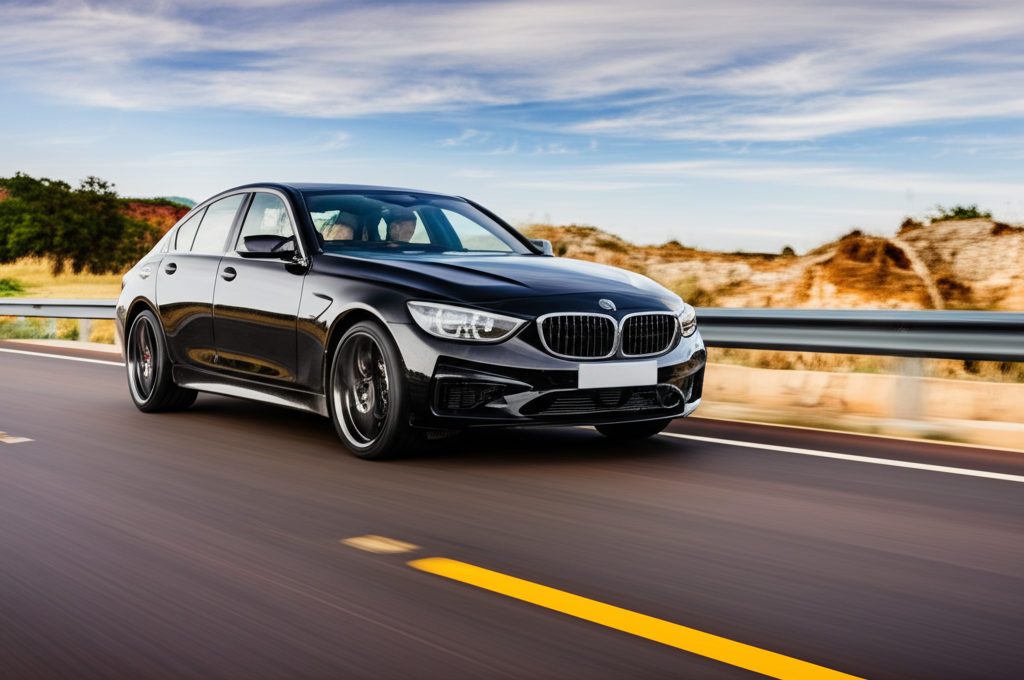That feeling is incredible, isn’t it? You’ve just picked up your car after a full repaint. Gone are the annoying scratches, the faded patches, the minor dings. Your vehicle looks brand new, gleaming under the Thai sun. You spent a significant amount of time, effort, and money to restore its beauty. But deep down, a nagging question might surface: How long will it stay this perfect? Driving on Thai roads, with the intense sun, unpredictable weather, flying debris, and tight parking spots, can feel like navigating a minefield for your car’s pristine finish. You just invested heavily in making it look perfect – the thought of getting another scratch or chip right away is frustrating, and potentially expensive all over again. So, the big question is: After spending all that money on new paint, do you really need to spend *more* on paint protection film (PPF)? Or is the new paint enough? Let’s explore why protecting that fresh paint job might be the smartest investment you make, helping you protect it right the first time and stop wasting money on future repairs.

From Frustration to Freedom: Alex’s Repaint & PPF Journey
Meet Alex, a Bangkok resident and proud owner of a recently repainted Honda Civic. Like many drivers in Thailand, his car had accumulated its fair share of battle scars over the years – minor scratches from parking mishaps, stone chips from highway drives upcountry, and some paint fading from the relentless UV exposure. Fed up with the tired look, Alex decided to invest in a full, high-quality repaint. The result was stunning; his Civic looked factory-fresh.
“I was thrilled with the new paint,” Alex recalls, “but almost immediately, I started worrying. Every time I parked, I was anxious about motorcycles squeezing past. Every highway trip made me nervous about gravel trucks. The joy of the new paint was mixed with constant stress.” A friend suggested Paint Protection Film (PPF), specifically the modern TPU (Thermoplastic Polyurethane) type.
Initially, Alex was hesitant. “More money? I just paid for the paint!” he thought. However, after doing some research and talking to a reputable installer, he understood the long-term value. He learned how TPU film acts as an invisible shield, absorbing impacts from small stones, preventing scratches from keys or bushes, and protecting the paint from harsh environmental factors like bird droppings and intense sun. He decided to protect his investment.
Alex opted for a full front-end PPF application (bonnet, bumper, fenders, mirrors) and protection for the door edges and door cups – high-impact and high-traffic areas. The installation process took a couple of days, involving meticulous cleaning and precise application of the clear film. When he got his car back, the difference wasn’t immediately visible – which was the point! The high-quality TPU film was virtually invisible, retaining the beautiful gloss of his new paint job. But the *change* was in Alex’s peace of mind. “Now,” he says, “I drive with confidence. I still park carefully, but the constant anxiety is gone. Washing the car is easier too, dirt just slides off. Knowing that my fresh paint is protected underneath makes the PPF investment totally worth it. I wish I’d known about this earlier – it would have saved me from needing the repaint in the first place!”

Understanding Your Options: What Exactly is TPU PPF and How Does it Compare?
So, you’ve got fresh paint. What are your options for protecting it, and why is TPU PPF often considered the ultimate solution, especially if you want to avoid future repaint costs?
What is TPU PPF?
TPU stands for Thermoplastic Polyurethane. It’s a high-performance polymer known for its elasticity, transparency, abrasion resistance, and chemical resistance. Modern automotive PPF is typically made from TPU and features several layers, including a self-healing top coat, the TPU layer itself, and an adhesive layer that bonds safely to your car’s paint.
Key Benefits of High-Quality TPU PPF:
- Physical Impact Protection: This is the main advantage over waxes or ceramic coatings. PPF acts as a physical barrier against stone chips, gravel, road debris, minor scrapes, and scratches.
- Self-Healing Properties: Minor swirls and scratches in the film’s top coat can disappear with exposure to heat (sunlight or warm water).
- UV Resistance: Quality PPF contains UV inhibitors that prevent the film itself from yellowing and, more importantly, protect the underlying paint from fading and oxidation caused by Thailand’s strong sunlight.
- Chemical & Stain Resistance: It guards your paint against damage from bird droppings, bug splatter, tree sap, acid rain, and harsh chemicals – contaminants that can etch into bare paint quickly.
- Enhanced Gloss & Hydrophobicity: Many PPFs add depth and gloss to the paint finish. They also have hydrophobic properties, meaning water beads up and rolls off, making the car easier to clean and stay clean longer.
- Preserves Resale Value: By keeping the original (or newly repainted) paint in pristine condition, PPF significantly helps maintain or even increase your car’s resale value.
How does PPF compare to other protection methods?
| Feature | Bare Paint (Newly Repainted) | Wax / Sealant | Ceramic Coating | TPU Paint Protection Film (PPF) |
|---|---|---|---|---|
| Primary Function | Looks good initially | Basic gloss enhancement, minimal temporary protection | Chemical resistance, hydrophobicity, gloss enhancement, minor swirl resistance | Physical impact & scratch protection, chemical resistance, UV protection, self-healing, gloss |
| Material | Paint Layers (Primer, Base, Clear Coat) | Natural (Carnauba) or Synthetic Polymers | Liquid SiO2/TiO2 Polymers (forms hard layer) | Thermoplastic Polyurethane (TPU) Film |
| Protection Against Stone Chips/Scratches | None / Very Vulnerable | Minimal / None | Very Minor / Limited | Excellent / Significant |
| Self-Healing (Minor Scratches) | No | No | No (some claim minor filling) | Yes (most quality TPU films) |
| UV Protection | Clear coat offers some, but fades over time | Minimal / Temporary | Good | Excellent (protects paint beneath) |
| Durability / Lifespan (Typical) | Varies, vulnerable immediately | Weeks to Months | 1-5+ Years (depending on product/maintenance) | 5-10+ Years (depending on product/maintenance) |
| Cost Range (Full Car – Indicative for Thailand) | N/A (Cost of Repaint already incurred) | Low (฿500 – ฿3,000) | Medium (฿10,000 – ฿50,000+) | High (฿40,000 – ฿150,000+) |
| Best Suited For | Needs immediate protection | DIY enthusiasts, basic short-term gloss | Ease of cleaning, chemical protection, gloss lovers | Maximum protection, preserving new/perfect paint, long-term value, peace of mind |
Who Should Seriously Consider PPF After a Repaint?
- Owners who want maximum protection: If the primary goal is to prevent physical damage and keep the paint looking new for years, PPF is the best solution.
- Those frustrated by previous damage: If you got the repaint specifically because of chips and scratches, PPF prevents the cycle from repeating.
- High-mileage drivers or those on rough roads: Increased exposure means higher risk; PPF provides necessary defense.
- Owners planning long-term ownership: The upfront cost is offset by avoiding future repairs and maintaining the car’s appearance over many years.
- Anyone seeking peace of mind: Reducing the stress associated with potential paint damage can significantly enhance driving enjoyment.
Essentially, if your motivation for repainting was to restore perfection, PPF is the logical next step to *maintain* that perfection and truly protect your investment properly the first time after the repaint.
Voices from the Road: What Thai Car Owners Say After Getting PPF
Don’t just take our word for it. Here’s what other car owners in Thailand who invested in PPF after paintwork have shared:
“After spending a fortune on a custom paint job for my modified Toyota Hilux, I was terrified of damaging it. Getting full PPF was non-negotiable. Months later, after countless trips off-road and through construction zones, the paint underneath is flawless. The film took a few hits, but self-healed most minor marks. Huge relief!” – Khun Pongsak, Chiang Mai
“My Mercedes got a repaint on the front bumper due to parking scrapes. I decided to wrap the new bumper and the hood in PPF. Best decision ever. No more cringing when I hear pebbles hitting the front on the expressway. It just gives you confidence that the expensive new paint is safe.” – Ms. Siriporn, Bangkok
“I was skeptical about the cost of PPF after repainting my Mazda 3. But thinking about the potential cost and hassle of *another* repaint convinced me. Now, washing the car is quicker, it always looks glossy, and I don’t worry about the kids accidentally scratching it with their bikes in the garage. The worry is gone, replaced by pride in how good the car looks.” – Mr. David, Pattaya
The common theme? Initial hesitation about cost transformed into immense satisfaction and relief. The feeling shifts from anxiety about potential damage to confidence and peace of mind, knowing their investment is properly shielded.
Ready to Protect Your Fresh Paint Job the Right Way?
You’ve already made the significant investment in bringing your car’s paint back to life. Don’t let that investment be short-lived due to the unavoidable hazards of driving in Thailand. Applying high-quality TPU Paint Protection Film is the ultimate step to safeguard that beautiful new finish, prevent future damage, maintain your car’s value, and eliminate the stress of potential scratches and chips. It’s about protecting it properly, once, so you don’t waste money on costly touch-ups or another repaint down the line.
Want to learn more about the best PPF options for your specific car model and driving needs in Thailand? Get expert advice and a personalized quote. Contact us today for a free consultation!
📱 Want to learn more about car wrap & paint protection?
Feel free to reach us on LINE:

🌐 Official Website: https://tpuwraps.com
Frequently Asked Questions (FAQ) for Post-Repaint PPF
- Q: How long do I need to wait after my car is repainted before applying PPF?
- A: This is crucial! You need to allow the new paint to fully cure and outgas. Most professional paint shops and PPF installers recommend waiting at least 30 days, but sometimes longer depending on the paint system used and curing methods (e.g., baking). Applying PPF too soon can trap solvents and potentially damage the paint. Always consult with both your paint shop and your PPF installer for the specific recommended waiting period for your situation.
- Q: Will installing or removing PPF damage my new paint?
- A: When installed and removed correctly by experienced professionals using high-quality film, PPF should not damage healthy, properly cured factory or professionally applied paint. Issues typically arise from poor installation techniques, low-quality films with aggressive adhesives, or attempting removal from poorly prepped or uncured paint. Choose a reputable installer!
- Q: Is PPF completely invisible?
- A: High-quality modern TPU PPF is extremely clear and virtually invisible on most paint colours. You might notice a very faint edge line upon close inspection, especially on lighter coloured cars, but from a normal viewing distance, it’s designed to be undetectable while often enhancing the paint’s gloss.
- Q: What’s the typical cost for PPF installation in Thailand after a repaint?
- A: Costs vary significantly based on the car size, complexity of the panels, the amount of coverage desired (e.g., front end only, full car), the brand and quality of the film, and the installer’s expertise. For a full front-end (bonnet, bumper, fenders, mirrors), expect costs roughly from ฿20,000 to ฿60,000+. A full car wrap can range from ฿60,000 to ฿150,000 or more for high-end films and complex vehicles. It’s best to get specific quotes.
- Q: I just repainted my car. Can’t I just get a good ceramic coating instead of PPF?
- A: While ceramic coatings offer excellent chemical resistance, UV protection, hydrophobicity (making cleaning easier), and enhanced gloss, they provide very little protection against physical impacts like stone chips or scratches. PPF is a physical barrier. Many owners choose to apply *both* – PPF on high-impact areas for physical protection, and ceramic coating over the PPF and the rest of the car for maximum ease of cleaning and environmental protection. If your main concern after repainting is preventing chips and scratches, PPF is the necessary solution.
Your Final Step to Lasting Perfection
Repainting your car was about restoring its beauty and your pride in ownership. Now, take the final step to preserve that perfection. Investing in TPU Paint Protection Film isn’t just an added expense; it’s the smartest way to protect your primary investment – the paint job itself. It’s the proactive measure that shields your car from the realities of the road in Thailand, saving you money, time, and frustration in the long run.
Stop worrying about that first inevitable scratch on your new paint. Drive with confidence, enjoy the effortless cleaning, and maintain that showroom shine for years to come. Protect it right, protect it once with PPF.
